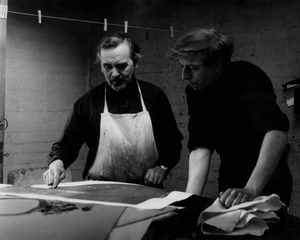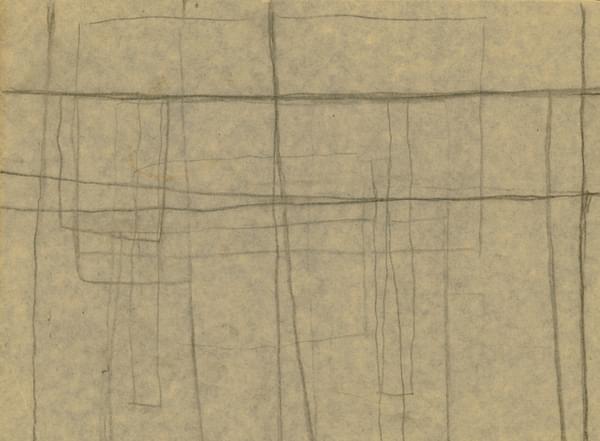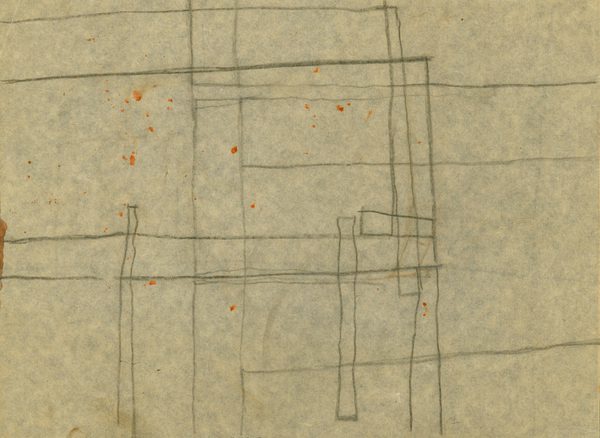William Scott
Photograph: William Scott and Stanley Jones at the Curwen Studio, 1961*
William Scott was one of the first artists in Britain, along with Patrick Heron, to develop a dialogue with America's Abstract Expressionists and to evolve this influence into an independently British movement. Although born in Scotland in 1913, he is generally held by the Irish to be one of their own, having grown up in Northern Ireland from the age of 9 and having studied at the Belfast School of Art. Scott matured into an internationally famous artist, and at the height of his career he would represent Great Britain at the Venice Biennale.
His early career was varied. Studies at the Royal Academy Schools, of both sculpture and painting, preceded travels, studies, exhibitions and the establishment of an art school in France. World War II forced him to return to England and he joined the Army, becoming a lithographic draughtsman with the Royal Engineers. After the war, he took up the position of Senior Painting Master at the Bath Academy of Art at Corsham Court. His painting, until the early 1950s was realistic in style with a preoccupation for still-life, although this soon changed. Scott travelled frequently to Cornwall where he had become friends with many of the St Ives Group of artists. He, and others from that group, was one of the sixty artists invited by the Arts Council to exhibit as part of the celebrations of the Festival of Britain. Scott’s work moved closer to non-figuration and, in 1953, an extended visit to North America resulted in friendships with New York based artists including Rothko and de Kooning.
By 1956, Scott’s success as an artist, both nationally and internationally, allowed him to give up full-time teaching, although he would remain interested in, and involved with, art school education for the rest of his life. In 1958 he represented Great Britain at the Venice Biennale, one of many occasions on which his work was chosen by the British Council to be exhibited abroad. Major shows followed in London, Tokyo, Paris, São Paulo and Zurich. In 1963 he was invited to take up the offer a 12-month residency in Berlin by the Ford Foundation.
In 1972, the Tate Gallery held a long-expected, major retrospective which cemented his fame.
*This photograph was taken in the original Curwen Studio premises by Michael Peito in 1961. At the time, William Scott (left) was in the midst of proofing ‘Mingulay’ - one of four lithographs commissioned by Timothy Simon – director of the Curwen Press and Studio. The prints were hand drawn by Scott using a combination of stone and zinc plate and were later published in 1962 in editions of 75 copies. The photograph demonstrates Scott’s involvement in the making of the four images, which were to form an important development in his printmaking.
Several rare catalogues and books about William Scott are available for sale in our bookshop.
Public Collections:
William Scott's works are in the collections of the following museums and galleries:
Australia
National Gallery of Australia, Canberrra
National Gallery of New South Wales, Sydney
National Gallery of South Australia, Adelaide
National Gallery of Victoria, Melbourne
Queensland Art Gallery, Brisbane
Western Australia Art Gallery, Perth
Austria
Museum Moderner Kunst, Vienna
Brazil
Museu de Arte Contemporânea da Universidade de São Paulo / MAC-USP, São Paulo
Canada
National Gallery of Canada, Ottawa
Art Gallery of Ontario,Toronto
Beaverbrook Art Gallery, New Brunswick
Museum London, London
Finland
Sara Hildén Art Museum, Särkänniemi
France
Musée Nationale d’Art Moderne, Paris
Germany
Kunsthalle, Hamburg
Neue Nationalgalerie - Staatliche Museen zu Berlin
Ireland
Hugh Lane Municipal Gallery of Modern Art, Dublin
Irish Museum of Modern Art, Dublin
National Gallery of Ireland, Dublin
Trinity College, Dublin
Italy
Galleria d’Arte Moderna, Genoa
Galleria Nationale d’Arte Moderna, Rome
Galleria Civica di Arte Moderna e Contemporanea, Turin
United Kingdom
Aberdeen Art Gallery and Museums
Abbot Hall Art Gallery, Kendal
Arts Council of Great Britain, London
Arts Council of Northern Ireland
Belfast Education and Library Board, Northern Ireland
Birmingham City Museum and Art Gallery
Bishop Otter College, Chichester
Brighton Museum and Art Gallery
Bristol's City Art Gallery
British Council, London
British Museum, London
Ferens Art Gallery, Kingston-upon-Hull
Fermanagh County Museum, Enniskillen
Fitzwilliam Museum, Cambridge
Hatton Gallery, Newcastle-upon-Tyne
Imperial War Museum, London
Kettle’s Yard, University of Cambridge
Leeds City Art Gallery
Leicestershire County Council
McManus Galleries and Museum, Dundee
National Museum Liverpool (The Walker)
National Museum of Wales, Cardiff
Nottingham Castle Museum and Art Gallery
Pallant House Gallery, Chichester
Royal Albert Memorial Museum, Exeter
Royal College of Art, London
Scottish National Gallery of Modern Art, Edinburgh
Sheffield City Art Galleries
Southampton City Art Gallery
Tate Gallery, London
Victoria and Albert Museum, London
Wakefield City Art Gallery
Whitworth Art Gallery, Manchester
Ulster Museum, Belfast
United States of America
Albright-Knox Art Gallery, Buffalo, NY
Baltimore Museum of Art, Maryland
Carnegie Institute, Pittsburgh
Hirshhorn Museum and Sculpture Garden, Smithsonian Institution, Washington DC
Houston Museum of Fine Arts, Texas
Museum of Modern Art, New York
Phoenix Art Museum, Arizona
Rhode Island School of Design Museum of Art, Rhode Island
Santa Barbara Museum of Art, California
Solomon R. Guggenheim Museum, New York
The Brooklyn Museum, New York
The Phillips Collection, Washington D.C.
Toledo Museum of Art, Ohio
University of Buffalo, Anderson Gallery, NY
University of Michigan Museum of Art, Michigan
Featured Artists
- Albers Anni
- Ancart Harold
- Andre Carl
- Avery Milton
- Baldessari John
- Barnes Ernie
- Calder Alexander
- Castellani Enrico
- Clough Prunella
- Crawford Brett
- Dadamaino
- de Tollenaere Saskia
- Dyson Julian
- Elsner Slawomir
- Freud Lucian
- Gadsby Eric
- Gander Ryan
- Guston Philip
- Haring Keith
- Hartung Hans
- Hayes David
- Held Al
- Hepworth Barbara
- Hill Anthony
- Hitchens Ivon
- Hockney David
- Hutchinson Norman Douglas
- Jenney Neil
- Katz Alex
- Kentridge William
- Knifer Julije
- Kusama Yayoi
- Le Parc Julio
- Leciejewski Edgar
- Léger Fernand
- Levine Chris
- Marchéllo
- Martin Kenneth
- Mavignier Almir da Silva
- Miller Harland
- Mitchell Joan
- Modé João
- Moore Henry
- Morellet François
- Nadelman Elie
- Nara Yoshitomo
- Nesbitt Lowell Blair
- Nicholson Ben
- O'Donoghue Hughie
- Pasmore Victor
- Perry Grayson
- Picasso Pablo
- Pickstone Sarah
- Prehistoric Objects
- Riley Bridget
- Ruscha Ed
- Sedgley Peter
- Serra Richard
- Shrigley David
- Smith Anj
- Smith Richard
- Soto Jesús Rafael
- Soulages Pierre
- Spencer Stanley
- Taller Popular de Serigrafía
- The Connor Brothers
- Vasarely Victor
- Vaughan Keith
- Whiteread Rachel
- Wood Jonas


